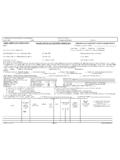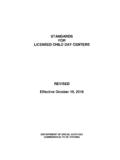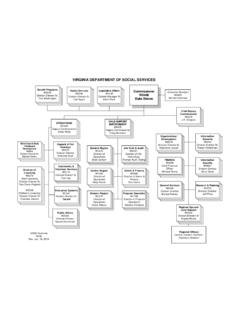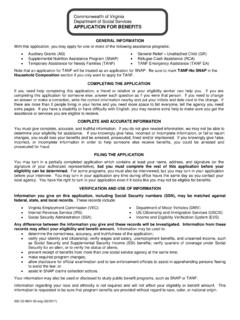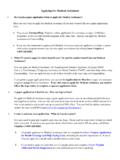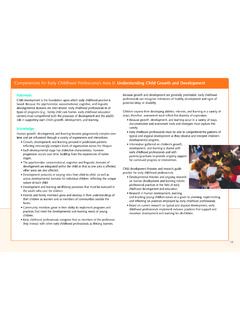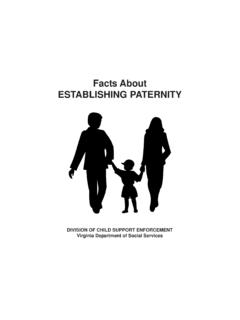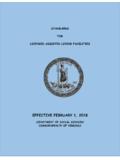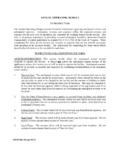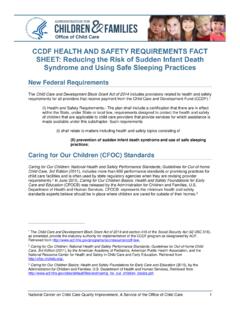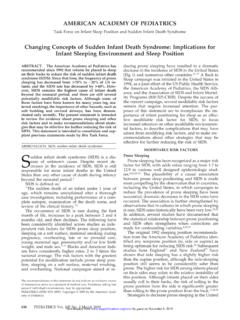Transcription of October is Sudden Infant Death Syndrome SIDS) Awareness …
1 Department of Health and Human Services (eagle) logo, Administration for Children and Families logo and Early Childhood Development logo. Below logos are 9 photos of children October is Sudden Infant Death Syndrome ( sids ) Awareness Month! By Katherine A. Beckmann, , , Senior Policy Advisor for Early Childhood Health and Development Office of the Deputy Assistant Secretary and Interdepartmental Liaison for Early Childhood About 3,500 babies die suddenly and unexpectedly each year in the United States.[1] These deaths are the result of unknown causes, Accidental Suffocation and Strangulation in Bed (ASSB), and Sudden Infant Death Syndrome ( sids ). sids is defined as an unidentified cause of Death in a baby younger than one year, even after the performance of an autopsy, examination of the Death scene, and review of the Infant s and family s clinical histories. Most sids deaths occur when babies are between one and four months of age and the majority (90%) of sids deaths occur before six months.
2 However, sids deaths can occur anytime during a baby's first year.[2] Approximately, 20 percent of sids -related deaths occur in child care settings.[3] The Safe to Sleep campaign (formerly known as Back to Sleep ) aims to educate parents, caregivers, and health care providers about ways to reduce to the risk of sids and other sleep-related causes of Infant Death . Over the past two decades, we ve made great progress in helping to reduce the risk of sids by more than 50 percent across the country, as a whole. However, disparities still exist. For example, African American infants are twice as likely as white infants to die of sids . Similarly, American Indian/Alaska Native infants are three times as likely as white infants to die of sids . [1] CDC, NCHS, Compressed Mortality File, cause of Death is determined using the following ICD-9 Codes: sids ( ), unknown cause ( ) and ASSB ( ).
3 For 2000-2013, cause of Death is determined using the following ICD-10 codes: sids (R95), unknown cause (R99) and ASSB (W75). [2] Trachtenberg, F., Haas, E., Kinney, H., Stanley, C., & Krous, H. (2012). Risk factor changes for Sudden Infant Death Syndrome after initiation of Back-to-Sleep campaign. Pediatrics, 129(4), 630-638. [3] Moon, R., Patel, K., & Shaefer, S. (2000). Sudden Infant Death Syndrome in child care settings, Pediatrics, 106, 295-300. How can you make a safe sleep environment? Always place baby on his or her back to sleep for all sleep times, including naps. Have the baby share your room, not your bed. Your baby should not sleep in an adult bed, on a couch, or on a chair alone, with you, or with anyone else. Try room sharing keeping baby's sleep area in the same room next to where you sleep Use a firm sleep surface, such as a mattress in a safety-approved crib, covered by a fitted sheet Keep soft objects, toys, pillows, crib bumpers, and loose bedding out of your baby's sleep area Dress your baby in no more than one layer of clothing more than an adult would wear to be comfortable, and leave the blanket out of the crib.
4 A one-piece sleeper or wearable blanket can be used for sleep clothing. Keep the room at a temperature that is comfortable for an adult. What can you do to spread the word? Now is a great time to start planning October events to get the word out about safe Infant sleep! Here are ideas and free resources to help you plan sids Awareness Month activities: Community events: Set up a booth at community events, such as health fairs, state fairs, or downtown markets. Educational seminars: Organize an educational seminar or presentation with specific populations, such as African American congregations, early childhood education students, first responders, or older community members. Fundraising events: If you're hosting a fundraising event, include Safe to Sleep materials in the registration packet. Public Service Announcements: Ask your local radio or TV station to share information about sids . If you have local stories to include, broadcasts with testimony from parents affected by Infant Death can be particularly powerful.
5 Display Resources: Create a display with information or brochures for use in children's hospitals, barber shops and hair salons, obstetrician offices, and pediatrician offices. For Families o Parents Guide to Safe Sleep o A grandparents brochure on safe Infant sleep (English and en espa ol) o A safe sleep environment one-pager (English and en espa ol) For Early Care and Education Providers o Participate in the free American Academy of Pediatrics online training, Reducing the Risk of sids in Child Care, and receive a certificate of completion for contact hour (per your specific state sids in-service requirements) o Child Care Providers Guide to Safe Sleep o Door hangers for general outreach, African American, and Hispanic communities o Brochures for general outreach as well as African American, American Indian/Alaska Native, and Hispanic communities o Use the Reducing the Risk of sids in Child Care Speaker's Kit to educate your community about sids in child care.
6 It is available in English and en espa ol. For General Education Training: o A Safe Infant Sleep video in English and en espa ol. o Healthy Native Babies Project materials for American Indian/Alaska Native communities o Brochures for general outreach as well as African American, American Indian/Alaska Native, and Hispanic communities For more information, please visit , , and
